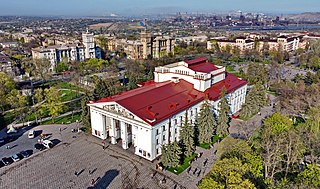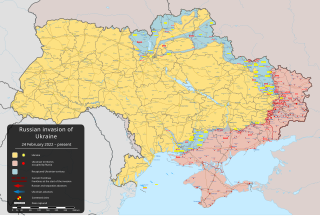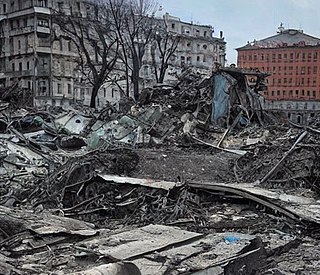
Mariupol is a city in Donetsk Oblast, Ukraine. It is situated on the northern coast (Pryazovia) of the Sea of Azov, at the mouth of the Kalmius River. Prior to the Russian invasion of Ukraine, it was the tenth-largest city in the country and the second-largest city in Donetsk Oblast, with an estimated population of 425,681 people in January 2022; Ukrainian authorities estimate the population of Mariupol at approximately 120,000. Mariupol has been occupied by Russian forces since May 2022.

Donetsk Academic Regional Drama Theatre was a theatre in Mariupol in southern Ukraine. The modern theatre was constructed in 1960 in the approximate location of the former Church of Mary Magdalene. The theatre was known as Donetsk Regional Drama Theatre before it was given academic status in November 2007. It was largely destroyed by Russian military airstrikes on 16 March 2022, resulting in the deaths of around 600 people.

The Azov Assault Brigade is a formation of the National Guard of Ukraine formerly based in Mariupol, in the coastal region of the Sea of Azov, from which it derives its name. It was founded in May 2014 as the Azov Battalion, a self-funded volunteer militia under the command of Andriy Biletsky, to fight Russian-backed forces in the Donbas War. It was formally incorporated into the National Guard on 11 November 2014, and redesignated Special Operations Detachment "Azov", also known as the Azov Regiment. In February 2023, the Ukrainian Ministry of Internal Affairs announced that Azov was to be expanded as a brigade of the new Offensive Guard.

Russian war crimes are the violations of the international criminal law including war crimes, crimes against humanity and the crime of genocide which the official armed and paramilitary forces of Russia are accused of committing since the dissolution of the Soviet Union in 1991. These accusations also extend to the aiding and abetting of crimes which have been committed by proto-statelets or puppet statelets which are armed and financed by Russia, including the Luhansk People's Republic and the Donetsk People's Republic. These war crimes have included murder, torture, terrorism, deportation or forced transfer, abduction, rape, looting, unlawful confinement, unlawful airstrikes or attacks against civilian objects, and wanton destruction.
The following is a list of events from the year 2022 in Ukraine.

On 24 February 2022, Russia invaded Ukraine in an escalation of the Russo-Ukrainian War that started in 2014. The invasion became the largest attack on a European country since World War II. It is estimated to have caused tens of thousands of Ukrainian civilian casualties and hundreds of thousands of military casualties. By June 2022, Russian troops occupied about 20% of Ukrainian territory. From a population of 41 million in January 2022, about 8 million Ukrainians had been internally displaced and more than 8.2 million had fled the country by April 2023, creating Europe's largest refugee crisis since World War II. Extensive environmental damage caused by the war, widely described as an ecocide, contributed to food crises worldwide.

The southern Ukraine campaign is an ongoing theatre of operation in the Russian invasion of Ukraine, which began on 24 February 2022. From their base in Russian-occupied Crimea, the Russian Armed Forces attacked Kherson Oblast, Mykolaiv Oblast, and Zaporizhzhia Oblast in southern Ukraine, battling the Armed Forces of Ukraine.

Since the beginning of the Russian invasion of Ukraine in 2022, the Russian military and authorities have committed war crimes, such as deliberate attacks against civilian targets ; indiscriminate attacks on densely-populated areas ; abduction, torture and murder of civilians; forced deportations; sexual violence; destruction of cultural heritage; and mistreatment, torture and murder of Ukrainian prisoners of war.

The siege of Mariupol began on 24 February 2022 and lasted until 20 May, as part of the Russian invasion of Ukraine. It saw fighting between the Russian Armed Forces and the Ukrainian Armed Forces for control over the city of Mariupol in southeastern Ukraine. Lasting for almost three months, the siege ended in a victory for Russia and the Donetsk People's Republic, as Ukraine lost control of the city amidst Russia's eastern Ukraine offensive and southern Ukraine offensive; all Ukrainian troops remaining in the city surrendered at the Azovstal Iron and Steel Works on 20 May 2022, after they were ordered to cease fighting.

The battle of Volnovakha was a military engagement which lasted from 25 February 2022 until 12 March 2022, as part of the Eastern Ukraine offensive during the 2022 Russian invasion of Ukraine. Russian and DPR forces engaged Ukrainian forces at the small city of Volnovakha in Donetsk Oblast, which is located close to the Ukrainian-DPR border.

On 9 March 2022, the Russian Air Force bombed Maternity Hospital No 3, a hospital complex functioning both as a children's hospital and maternity ward in Mariupol, Ukraine, during the Russian invasion of Ukraine, killing at least four people and injuring at least sixteen, and leading to at least one stillbirth.

Russia began an invasion of Ukraine on 24 February 2022, in a major escalation of the Russo-Ukrainian War that began in 2014. It is the largest military attack in Europe since World War II. During the fighting, many pieces of Ukrainian cultural heritage were either destroyed, damaged, or put at risk due to the widespread destruction across the country. This deliberate destruction and looting of over 500 Ukrainian cultural heritage sites is considered a war crime and has been described by Ukraine's Minister of Culture as cultural genocide.

On 16 March 2022, during the Russian invasion of Ukraine, the Russian Armed Forces bombed the Donetsk Academic Regional Drama Theatre in Mariupol, Ukraine. It was used as an air raid shelter during the siege of Mariupol, sheltering a large number of civilians. The estimations of the number of deaths that occurred due to the bombing have varied, from at least 12 to 600.

Filtration camps, also referred to as concentration camps, are camps used by Russian forces during the 2022 Russian invasion of Ukraine to register, interrogate, and detain Ukrainian citizens in regions under Russian occupation before transferring them into Russia, sometimes as part of forced population transfers. Filtration camp detainees undergo a system of security checks and personal data collection. Detainees are subject to widespread torture, killings, rape, starvation and other grave human rights violations.

During the Russian invasion of Ukraine, the Russian military have carried out deliberate attacks against civilian targets and indiscriminate attacks in densely-populated areas. The United Nations Human Rights Monitoring Mission in Ukraine says the Russian military exposed the civilian population to unnecessary and disproportionate harm by using cluster bombs and by firing other weapons with wide-area effects into civilian areas, such as missiles, heavy artillery shells and multiple launch rockets. As of 2024, the attacks had resulted in the documented deaths of between 10,000 and 16,500 civilians. On 22 April 2022, the UN reported that of the 2,343 civilian casualties it had been able to document, it could confirm 92.3% of these deaths were as a result of the actions of the Russian armed forces.
There have been several allegations of Russian mobile crematoriums operating with their forces in the Russian invasion of Ukraine.
This timeline of the Russian invasion of Ukraine covers the period from 24 February 2022, when Russia launched a military invasion of Ukraine, to 7 April 2022 when fighting focused away from the north and towards the south and east of Ukraine.
Following the Russian invasion of Ukraine on 24 February 2022, the Ukrainian city of Zaporizhzhia and the surrounding region became the target of repeated Russian shelling and bombing as part of the southern Ukraine offensive from 27 February 2022 onwards. Thirty to forty percent of the infrastructure in the city has been destroyed.
The 2022 bombing of Ivano-Frankivsk began on the first day of Russia's invasion of Ukraine with a series of missile strikes by Russia and Belarus.

The use of cluster munitions during the Russian invasion of Ukraine (2022–present) has been recorded by a number of eyewitnesses and journalists, as well as representatives of the UN, humanitarian and public organizations. In particular, the head of the UN Human Rights Council, Michelle Bachelet, reported on March 30 at least 24 cases since the beginning of the invasion. As of July 1, hundreds of attacks by Russian forces with cluster munitions have already been recorded in the settlements of the Dnipropetrovsk, Donetsk, Zaporizhzhia, Kyiv, Luhansk, Mykolaiv, Odesa, Sumy, Kharkiv, Kherson and Chernihiv regions. 215 civilians are known to have been killed in these shellings and 474 injured, many of which may go unreported. Both Russia as well as Ukraine have used cluster munitions during the conflict, however, Russian use has been extensive while Ukrainian use has been more limited.












